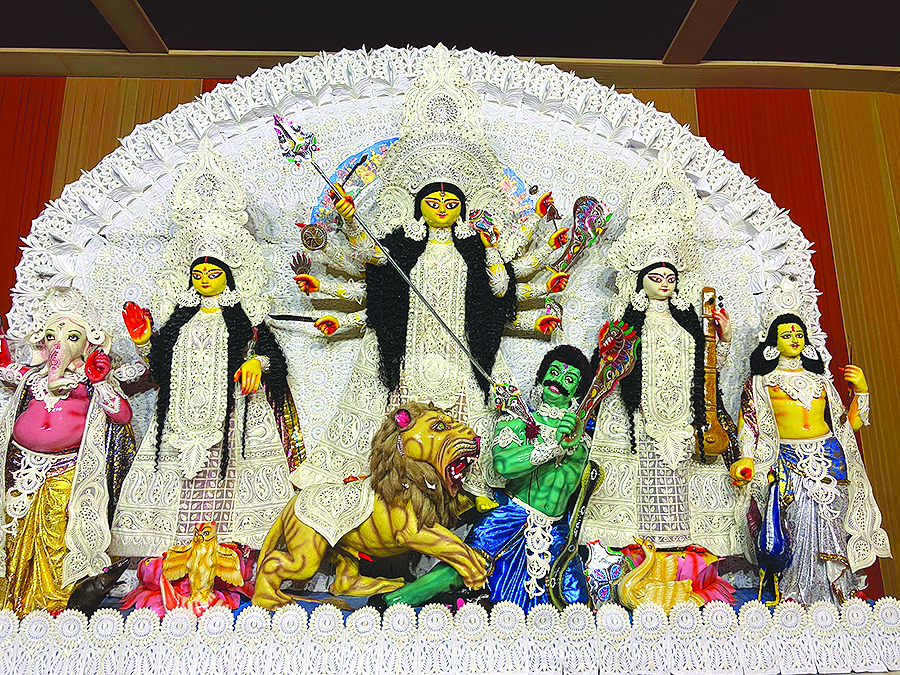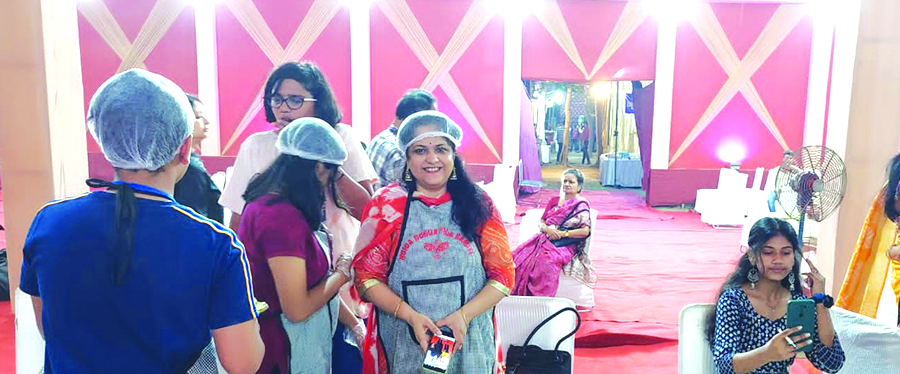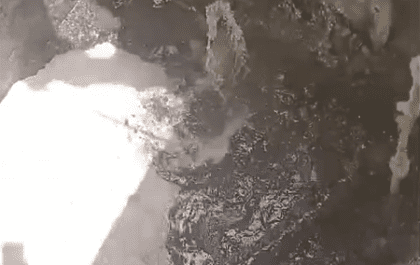by Charu Jain
The NBCA organised a full-scale celebration of Durga Puja at Kalibari Mandir after a gap of two years. Various events like rangoli, cooking competitions, Rabindra Sangeet competitions, and
cultural programs were showcased alongside the main pooja.
This year was especially important as it was the 40th year the Durga Puja is held at this site. The pooja started at this site in the year 1983, thus making it amongst the oldest pandals and Durga Poojas in the city.
While traditionally, Durga puja was organised in Basant, the Shardiya Navratri took precedence when Shri Ram worshipped Shakti or Durga before fighting Ravana.
The pandal that took over 45 days to be prepared was a replica of Belur Math temple which is located on the banks of the Hooghly River in West Bengal. The idea behind the theme was to send out a message about preserving the heritage of India.
Before the start of the celebrations, Tarpan was organised on the last day of the Shraddh or Pitrapaksha on 29 Sep. The celebrations began the next day and ended on October 5, the day of Dashami. The food festival, ‘Anando Mela’, was organised on September 30 and thereafter various competitions for children and cultural events were held.
The Anando Mela saw active participation from even the non-Bengali community of the sector along with the Bengali community from all over Noida. Sunita Patra (B-86) won a prize in the Rangoli competition as well as the 1st Prize in the Veg category for Raw Banana cutlets. Gunjan Jain (D-166) won the 2nd Prize for Kachori-Aloo ki Sabzi in the Veg category while her son Vatsal Jain, aged 12, won the 1st Prize for a veg gourmet sandwich in the Under-15 category. Charu Jain (D-166) won the 3rd Prize for eggless chocolate pudding in the desserts/sweet dish category. Mrs Shanta Bansal (B 36) won the 1st Prize in the Senior Citizen category for her Chaat Platter comprising golgappas and dahi-bhalla-papdi. Her daughter-in-law, Yogeshwari Bansal won the 1st Prize in Desserts category for Kesar Mawa Gujiya.
The pratima of Maa Durga and her children were brought into a boat (loaded on a truck). It is said that the Maa Durga comes in 4 ways – Horse, Elephant, Boat or Jhula. The mode of transport by which the Devi arrives is decided by the pandits. The pratima of the Devi was unveiled on 1 Oct with aartis being held daily. Bhog was distributed to hundreds of devotees daily. It is said that there are 4 signs of the coming of the festival – clouds in the sky, the flowering of harsingar (parijaat), the flowering of kaash phool (grass flower), and a new smell in the air. The puja of the Maa Durga has its origins in the worship of Mother Nature just before harvest time. Thus trees are worshipped by tying 9 trees together – Kela (banana), arbi (colocasia, haldi (turmeric), Jayanti, Bel, Anar (pomegranate), Arun, Rice plant, and Ashoka tree. These are placed near the idol. The idol is bathed in the water of 9 rivers or oceans though these days one makes do with the water of 9 wells. The Aahvan of the Devi happens on the 6th Navratri and the pran prathistha happens that day. 108 items are mixed to bathe the Devi and the bhog or Naivedyam is prepared with 5 fruits and raw rice.
Recitals, drama, dance drama, live band, quiz contest, painting, fashion show, dhunuchi dance (holding clay bowls filled with coconut husks and burning charcoal) are among the events planned around the puja.
On 5 Oct which is Dusshera or Ravana Vadh, many ladies came dressed in red and white sarees for Sindoor Khela and the immersion of the idols.
Many food stalls did brisk sales while the number of stalls selling clothes and trinkets was limited. The police were present in large numbers directing traffic as entry in many lanes of the sector around the temple was barred. Yet this led to irregular parking with residents complaining on Whatsapp groups.



Popular Stories
How To Revive Your Rainwater Harvesting System
The Water Couple’s Journey: From Cleaning Tanks to Complete Water Solutions!
Locals Felling Trees Near Sec A Pkt C
Winning Has Become a Habit for Divya
Is Green Park Heading Towards A Slum
Haphazard Parking, Narrow Walking Space In M Block Market
Recent Stories from Nearby
- A Riot of Colours and Joy at Imperial Holi April 15, 2025
- Festive Colours and Joy: Holi Celebration at PH-2 April 15, 2025
- Iftar Celebration at Imperial Court: An Evening of Togetherness and Gratitude April 15, 2025
- JAL Waiting For A New Sunrise April 15, 2025
- Wish Town Holi Milan: A Celebration of Unity, Joy, and Cultural Heritage April 15, 2025






